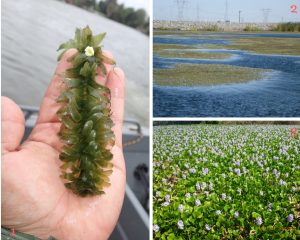 SACRAMENTO, California — The Division of Boating and Waterways (DBW) is set to begin this year’s efforts to control aquatic invasive plants in the Sacramento-San Joaquin Delta region and Suisun Marsh. Pending weather conditions, DBW will begin herbicide treatment next week for water hyacinth, South American spongeplant, Uruguay water primrose, alligatorweed, Brazilian waterweed, curlyleaf pondweed, Eurasian watermilfoil, coontail and fanwort as part of an integrated plant control program.
SACRAMENTO, California — The Division of Boating and Waterways (DBW) is set to begin this year’s efforts to control aquatic invasive plants in the Sacramento-San Joaquin Delta region and Suisun Marsh. Pending weather conditions, DBW will begin herbicide treatment next week for water hyacinth, South American spongeplant, Uruguay water primrose, alligatorweed, Brazilian waterweed, curlyleaf pondweed, Eurasian watermilfoil, coontail and fanwort as part of an integrated plant control program.
Aquatic invasive plants have no known natural controls in the Delta and negatively affect the ecosystem by displacing native plants. They also create safety hazards for boaters and obstruct navigation channels, marinas and irrigation systems.
DBW continuously works with local, state and federal entities to apply the latest science on the Delta’s aquatic invasive plants and strategies to control them. This year, DBW will use new integrated control strategies such as biocontrols and remote sensing to increase the efficiency of treatment efforts and protect the Delta and the public. Herbicides are used in strict adherence to regulatory requirements, permits, best management practices and protocols. An extensive water quality-monitoring program is carried out by DBW to ensure compliance with all water quality standards, including drinking water standards.
“We take our responsibility seriously to control aquatic invasive plants in the Delta while at the same time protecting the environment, agriculture, public health and water quality,” said DBW’s Acting Deputy Director Ramona Fernandez. “To minimize impacts from our use of herbicides, we continue to leverage technology and resources through collaboration and cooperation with the public and our local, state and federal partners who are helping us manage this challenge. Our partnerships and frequent communication with state and federal regulators provides valuable guidance on meeting significant regulatory requirements while implementing a successful program.”
A media call will be held tomorrow, March 8, to allow reporters to ask questions about the treatment plan.
WHAT: Media Call on 2019 Aquatic Invasive Plant Control Program
WHEN: Friday, March 8, 12 to 1 p.m.
WHO: State and federal entities from: Division of Boating and Waterways, US Department of Agriculture, California
Department of Fish and Wildlife, State Water Resources Control Board, Delta Stewardship Council, Delta
Protection Commission
CALL: (888) 790-1807 I Code: 8615610
DBW’s decisions to use specific treatment methods are based on their effectiveness for specific plants, locations and conditions. Herbicide use is carefully controlled and has been reviewed and approved by the U.S. Fish and Wildlife Service, National Marine Fisheries Service, California Department of Pesticide Regulation, the State Water Resources Control Board and County Agricultural Commissioners’ offices for local herbicide use restrictions. All herbicides are registered for aquatic use with the U.S. Environmental Protection Agency and California Department of Pesticide Regulation.
Below is additional information on the permits and safety protocols DBW adheres to:
- Biological Opinions (BOs): Mutually agreed upon protocols/conditions approved by the U.S. Fish and Wildlife Service and National Marine Fisheries Service.
- BOs are designed to protect endangered species, guide acreage treated, specify the kinds of treatment used, including which herbicides and what species to control, and treatment dates.
- Protocols regarding the levels of herbicides to use and requirements for extensive water quality and environmental monitoring are also part of the BOs.
- Lake and Streambed Alteration Agreement: DBW obtains an agreement from the California Department of Fish and Wildlife for mechanical harvesting efforts.
- Clean Water Act: For herbicide treatment, the division obtains a permit from the State Water Resources Control Board.
- Pesticide Use Permits and Notices: DBW works very closely with 11 County Agricultural Commissioners within the Delta region.
- Training: DBW’s applicator staff attend annual trainings to ensure that they are well versed in the herbicides being used, as well as safety protocols and methods for minimizing impacts on the environment.
- Monitoring: Treated areas are monitored to ensure herbicide levels do not exceed allowable limits.
A summary of this year’s treatment season can be viewed online at www.dbw.parks.ca.gov/AIS.
Last year, DBW treated 2,293.42 acres (150 sites) of floating aquatic vegetation and 4,360 acres (71 sites) of submersed aquatic vegetation. Mechanical harvesting efforts totaled 9.70 acres. The division anticipates 2019 to have wetter conditions compared to 2018. A combination of herbicide, biological and mechanical control methods will be used to help control invasive plants at high priority sites in the Delta.
In 1982, California state legislation designated DBW as the lead state agency to cooperate with other state, local and federal agencies in controlling water hyacinth in the Delta, its tributaries, and the Suisun Marsh. The Egeria Densa Control Program was authorized by law in 1997 and treatment began in 2001. In 2012, Spongeplant was authorized for control upon completion of the biological assessment. In 2013, DBW was able to expand its jurisdiction to include other invasive aquatic plants, and since then other aquatic invasive plants such as Uruguay water primrose, Eurasian watermilfoil, Carolina fanwort, coontail, and alligatorweed have been added to the AIPCP.

